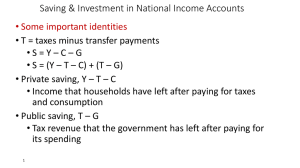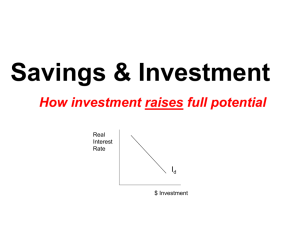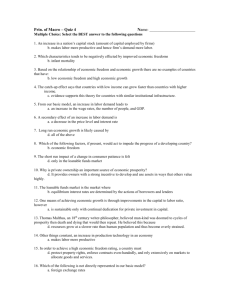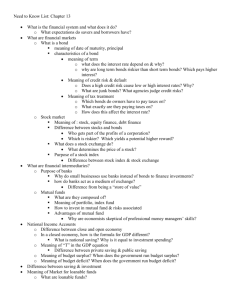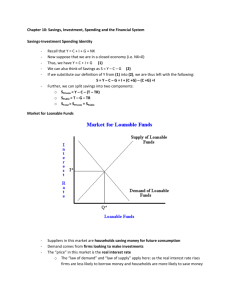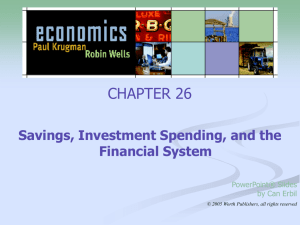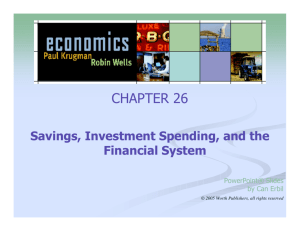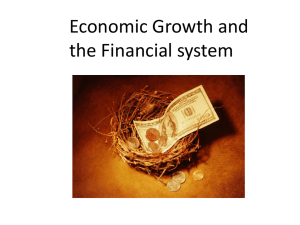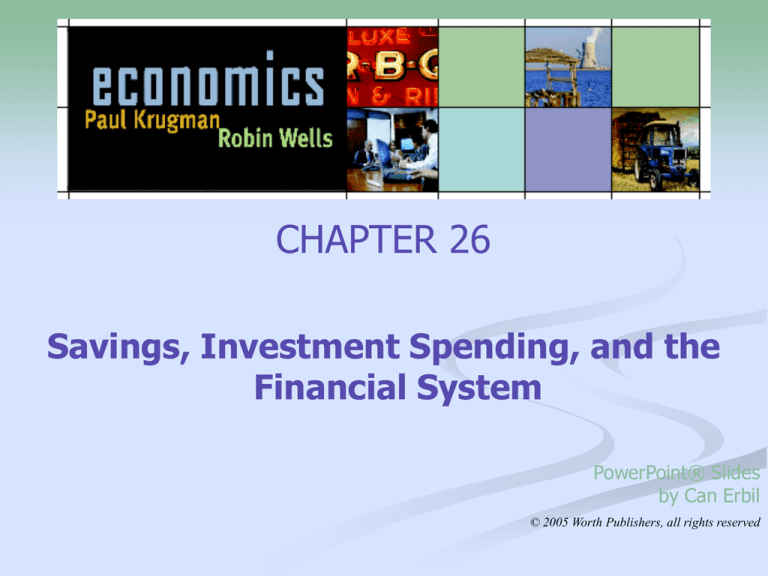
CHAPTER 26
Savings, Investment Spending, and the
Financial System
PowerPoint® Slides
by Can Erbil
© 2005 Worth Publishers, all rights reserved
What you will learn in this chapter:
The relationship between savings and investment spending
About the loanable funds market, which shows how savers
are matched with borrowers
The purpose of the four principal types of assets: stocks,
bonds, loans, and bank deposits
How financial intermediaries help investors achieve
diversification
Some competing views of what determines stock prices and
why stock market fluctuations can be a source of
macroeconomic instability
The Savings–Investment Spending Identity in a
Closed Economy
In a closed economy: GDP = C + I + G
SPrivate = GDP + TR − T − C
SGovernment = T − TR − G
NS = SPrivate + SGovernment = (GDP + TR − T − C) + (T − TR − G)
= GDP − C − G
Hence, I = NS
Investment spending = National savings in a closed
economy
Budget Surplus and Budget Deficit
The Savings–Investment Spending Identity
in an Open Economy
I = SPrivate + SGovernment + (IM – X) = NS + KI (10)
Investment spending = National savings + Capital inflow
in an open economy
The Savings-Investment Spending Identity in
Open Economies: the United States and Japan
2003
The Meaning of Saving and Investment
Private saving is the income remaining after
households pay their taxes and pay for consumption.
Examples of what households do with saving:
buy corporate bonds or equities
purchase a certificate of deposit at the bank
buy shares of a mutual fund
let accumulate in saving or checking accounts
The Meaning of Saving and Investment
Investment is the purchase of new capital.
Examples of investment:
General Motors spends $250 million to build
a new factory in Flint, Michigan.
You buy $5000 worth of computer equipment for your
business.
Your parents spend $300,000 to have a new house
built.
Remember: In economics, investment is NOT
the purchase of stocks and bonds!
The Market for Loanable Funds
A supply-demand model of the financial system.
Helps us understand
how the financial system coordinates
saving & investment
how government policies and other factors affect
saving, investment, the interest rate
The Market for Loanable Funds
Assume: only one financial market.
All savers deposit their saving in this market.
All borrowers take out loans from this market.
There is one interest rate, which is both the return to
saving and the cost of borrowing.
The Market for Loanable Funds
The supply of loanable funds comes from saving:
Households with extra income can loan it out and earn
interest.
SHIFTS in the Supply Curve:
Changes
in private savings behavior
Changes
in capital flows
The Slope of the Supply Curve
Interest
Rate
Supply
6%
3%
60
80
An increase in
the interest rate
makes saving
more attractive,
which increases
the quantity of
loanable funds
supplied.
Loanable Funds
($billions)
The Market for Loanable Funds
The demand for loanable funds comes from investment:
• Firms borrow the funds they need to pay for new
equipment, factories, etc.
• Households borrow the funds they need to
purchase new houses.
•
SHIFTS in the Demand Curve
• Changes in perceived business opportunities
• Changes in government’s borrowing
The Slope of the Demand Curve
A fall in the interest
rate reduces the cost
of borrowing, which
increases the quantity
of loanable funds
demanded.
Interest
Rate
7%
4%
Demand
50
80 Loanable Funds
($billions)
Equilibrium
Interest
Rate
Supply
The interest rate
adjusts to equate
supply and demand.
The eq’m quantity
of L.F. equals
eq’m investment
and eq’m saving.
5%
Demand
60
Loanable Funds
($billions)
Policy 1: Saving Incentives
Interest
Rate
S1
S2
5%
4%
D1
60 70
Tax incentives for
saving increase
the supply of L.F.
…which reduces the
eq’m interest rate
and increases the
eq’m quantity of L.F.
Loanable Funds
($billions)
Policy 2: Investment Incentives
Interest
Rate
An investment tax
credit increases the
demand for L.F.
S1
6%
5%
D2
…which raises the
eq’m interest rate
and increases the
eq’m quantity of L.F.
D1
60 70
Loanable Funds
($billions)
A C T I V E L E A R N I N G 2:
Exercise A.
Use the loanable funds model to analyze
the effects of a government budget deficit:
Draw the diagram showing the initial equilibrium.
Determine which curve shifts when the government
runs a budget deficit.
Draw the new curve on your diagram.
What happens to the equilibrium values of the
interest rate and investment?
18
A C T I V E L E A R N I N G 2:
Exercise B.
Use the loanable funds model to analyze the effects
of tax decrease on the interest earned on savings.
How does the tax decrease on interest on savings
affect the market?
Draw the diagram showing the initial equilibrium.
Determine which curve shifts when the government runs a
budget deficit.
Draw the new curve on your diagram.
What happens to the equilibrium values of the interest rate and
investment?
19
Policy 3. Government Budgets
Budget Deficits, Crowding Out,
and Long-Run Growth
Our analysis: increase in budget deficit causes fall in
investment.
The govt borrows to finance its deficit,
leaving less funds available for investment.
This is called crowding out.
Recall from the preceding chapter: Investment is
important for long-run economic growth.
Hence, budget deficits reduce the economy’s growth rate
and future standard of living.
The U.S. Government Debt
The government finances deficits by borrowing (selling
government bonds).
Persistent deficits lead to a rising govt debt.
The ratio of govt debt to GDP is a useful measure of the
government’s indebtedness relative to its ability to raise
tax revenue.
Historically, the debt-GDP ratio usually rises during
wartime and falls during peacetime – until the early
1980s.
U.S. Government Debt
as a Percentage of GDP, 1970-2007
120%
WW2
100%
80%
60%
40%
Revolutionary
War
Civil
War
WW1
20%
0%
1790 1810 1830 1850 1870 1890 1910 1930 1950 1970 1990 2010
The Financial System - Definitions
Wealth
Financial asset
Physical asset
Liability
Transaction costs
Financial risk
Risk-Averse Attitudes Toward Gain and Loss
Three Tasks of a Financial System
Reducing transaction costs
Reducing financial risk
Providing liquid assets
Financial Intermediaries
Mutual funds
Pension funds
Life insurance companies
Banks
Financial Fluctuations
Financial market fluctuations can be a source of
macroeconomic instability.
Are markets irrational?
Policy makers assume neither that markets always
behave rationally nor that they can outsmart them.
The End of Chapter 26
coming attraction:
Chapter 27:
Aggregate Supply and
Aggregate Demand



